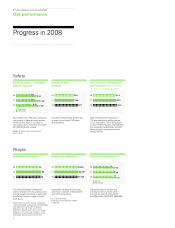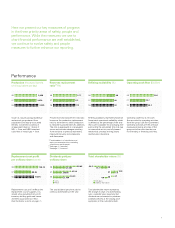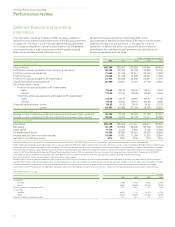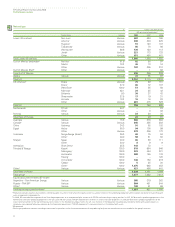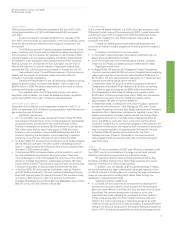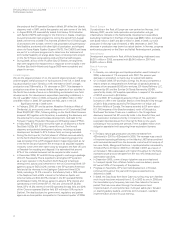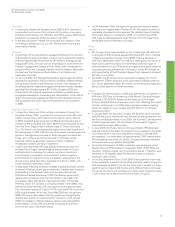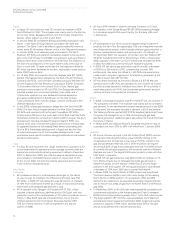BP 2008 Annual Report Download - page 17
Download and view the complete annual report
Please find page 17 of the 2008 BP annual report below. You can navigate through the pages in the report by either clicking on the pages listed below, or by using the keyword search tool below to find specific information within the annual report.
BP Annual Report and Accounts 2008
Performance review
• In Refining and Marketing, we have a strong presence in the US and
Europe. In the US, we market under the Amoco and BP brands in the
midwest, east and south-east and under the ARCO brand on the west
coast, and in Europe, under the BP and Aral brands. We have a long-
established supply and trading activity responsible for delivering value
across the crude and oil products supply chain. Our Aromatics &
Acetyls business maintains a manufacturing position globally, with
emphasis on growth in Asia. We also have, or are growing,
businesses elsewhere in the world under the BP and Castrol brands,
including a strong global lubricants portfolio and other business-to-
business marketing businesses (aviation and marine) covering the
mobility sectors. We continue to seek opportunities to broaden our
activities in growth markets such as China and India.
Through non-US subsidiaries or other non-US entities, during the period
covered by this report, BP conducted limited marketing, licensing and
trading activities in, or with persons from, certain countries identified by
the US Department of State as State Sponsors of Terrorism. BP believes
that these activities are immaterial to the group.
BP has interests in, and is the operator of, two fields and a pipeline
located outside Iran in which the National Iranian Oil Company (NIOC)
and an affiliated entity have interests. In Iran, BP buys small quantities of
crude oil. This is primarily for sale to third parties in Europe and a small
portion is used by BP in its own refineries in South Africa and Europe. In
addition, BP sells small quantities of crude oil into Iran and blends and
markets small quantities of lubricants for sale to domestic consumers
through a joint venture there, which has a blending facility. However,
BP does not seek to obtain from the government of Iran licences or
agreements for oil and gas projects in Iran, is not conducting any
technical studies in Iran and does not own or operate any refineries
or chemicals plants in Iran.
BP sells small quantities of lubricants in Cuba through a 50/50
joint venture there. In Syria, small quantities of lubricants are sold
through a distributor and BP obtains small volumes of crude oil
supplies for sale to third parties in Europe. In addition, BP sells small
quantities of crude oil into Syria. These sales and purchases are
insignificant and BP does not provide other goods, technologies or
services in these countries.
Market context
Our market is a complex and fast-moving environment. In 2008, volatile
energy price movements mirrored unsettled financial markets and wider
economic uncertainty (see Risk factors on page 12). World oil
consumption fell in 2008, with growing demand in fast growing non-
OECD countries more than offset by falling consumption in the OECD
countries. Gas consumption grew in the major markets. Anxieties
around energy security continued, with individual consumer countries
facing specific issues related to cost, geography and political
relationships with producers. In terms of supply, substantial global
reserves of oil and gas are in place but government, energy companies
and industry must work together to bring these to market. There is also
a clear need for greater energy diversity to address the competing
challenges of growing demand and climate change. In terms of human
resources, the energy industry also faces a shortage of professionals
such as petroleum engineers and scientists.
Acquisitions and disposals
There were no significant acquisitions in 2006, 2007 or 2008.
In 2008, we completed an asset exchange with Husky Energy
Inc., and asset purchases from Chesapeake Energy Corporation as
described on page 51.
In 2007, BP acquired Chevron’s Netherlands manufacturing
company, Texaco Raffiniderij Pernis B.V. The acquisition included
Chevron’s 31% minority shareholding in Nerefco, its 31% shareholding in
the 22.5MW wind farm co-located at the refinery as well as a 22.8%
shareholding in the TEAM joint venture terminal and shareholdings in two
local pipelines linking the TEAM terminal to the refinery. Disposal
proceeds were $4,267 million, which included $1,903 million from the
sale of the Coryton refinery and $605 million from the sale of our
exploration and production gas infrastructure business in the Netherlands.
In 2006, BP purchased 9.6% of the shares issued under Rosneft’s
IPO for a consideration of $1 billion (included in capital expenditure). This
represented an interest of around 1.4% in Rosneft. Disposal proceeds
were $6,254 million, which included $2.1 billion on the sale of our
interest in the Shenzi discovery and around $1.3 billion from the sale of
our producing properties on the Outer Continental Shelf of the Gulf of
Mexico to Apache Corporation.
Resegmentation in 2008
On 11 October 2007, BP announced that it was to simplify its
organizational structure by reducing the number of business segments.
From 1 January 2008, BP has two business segments:
Exploration and Production and Refining and Marketing. A separate
business, Alternative Energy, handles BP’s low-carbon businesses and
future growth options outside oil and gas and reports under Other
businesses and corporate.
As a result, and with effect from 1 January 2008:
• The former Gas, Power and Renewables segment ceased to
report separately.
• The NGLs, LNG and gas and power marketing and trading businesses
were transferred from the Gas, Power and Renewables segment to
the Exploration and Production segment.
• The Alternative Energy business was transferred from the Gas, Power
and Renewables segment to Other businesses and corporate.
• The Emerging Consumers Marketing Unit was transferred from
Refining and Marketing to Alternative Energy (which is reported in
Other businesses and corporate).
• The Biofuels business was transferred from Refining and Marketing
to Alternative Energy (which is reported in Other businesses
and corporate).
• The Shipping business was transferred from Refining and Marketing to
Other businesses and corporate.
16


